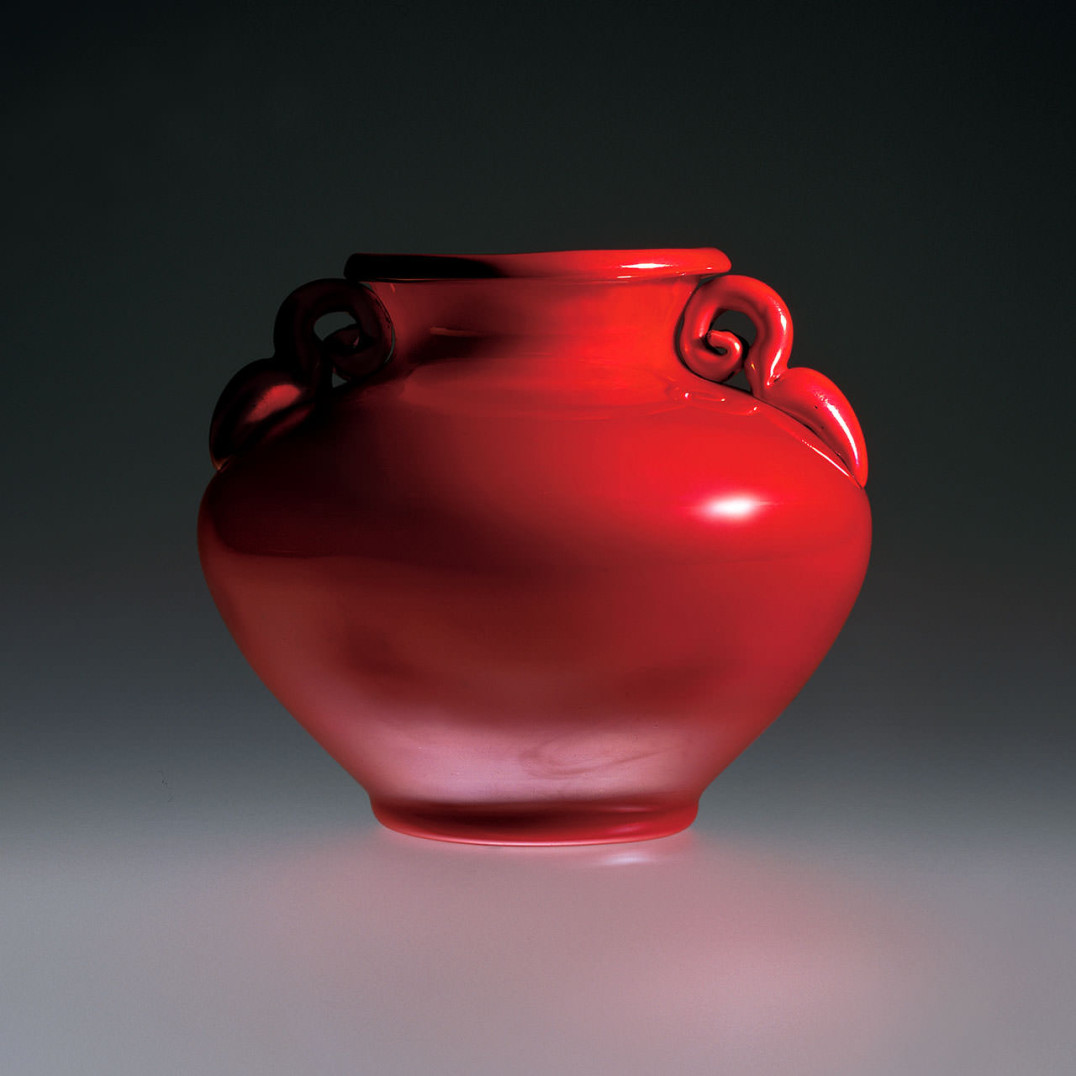
Napoleone MartinuzziPasta vitrea, 1933
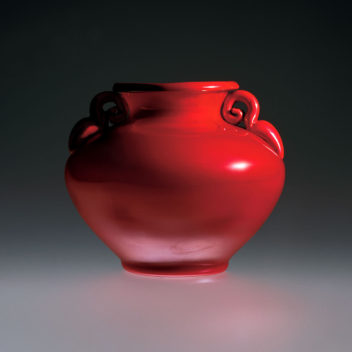
Napoleone MartinuzziPasta vitreaZecchin-Martinuzzi Vetri Artistici e Mosaici, 1933
Vessel in coral pasta vitrea with applied small handles and base.
Original paper label.
7 3/4 in. high (19.7 cm)
Exhibitions:
2001, Milan, Murano: Vetri dalla Collezione Olnick Spanu, Spazio Oberdan.
Bibliography and comparative texts:
Catalogue Zecchin-Martinuzzi,
n. 2432;
Olnick Spanu, 2001, n. 27.
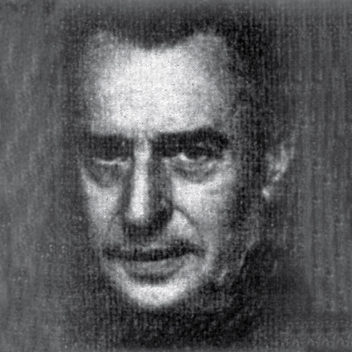
Napoleone Martinuzzi 1892–1977
The son of a glassworker from Murano, Napoleone Martinuzzi was a sculptor, designer, and businessman. He attended the Accademia di Belle Arti di Venezia, and later joined the secessionist group of Cà Pesaro, where he exhibited his sculptures in 1908. From 1917 on, he was Gabriele D'Annunzio's favorite artist and he designed a funeral monument for him, as well as sculpture and many works in glass, which may still be seen today at the Vittoriale. Between 1921 and 1931, he directed the Museo Vetrario di Murano, and in 1925 he became a partner and artistic director at the Vetri Soffiati Muranesi Venini & C. After carrying on the concepts defined by his predecessor, Vittorio Zecchin, and creating beautifully transparent blown glass pieces, he elaborated on his own distinct style, directly derived from his experience as a Novecento sculptor. In 1928, he made his first pieces in pulegoso glass, giving life to a sculptural series of vessels with impressive shapes and vivid colors, as well as an unusual collection of cacti, fruits, and animals. After leaving Venini, in 1932 he founded Zecchin-Martinuzzi Vetri Artistici e Mosaici with Francesco Zecchin, for which he designed figures of animals and cacti, opaque vessels with classical shapes, and female nudes in solid massiccio glass. He became artistic director of Alberto Seguso's Arte Vetro, where he made glass sculptures shaped while hot. Between 1953 and 1958, he designed chandeliers and glass tiles for the Vetreria Cenedese. In the '60s and '70s, he designed works produced by Alfredo Barbini for Pauly & C.
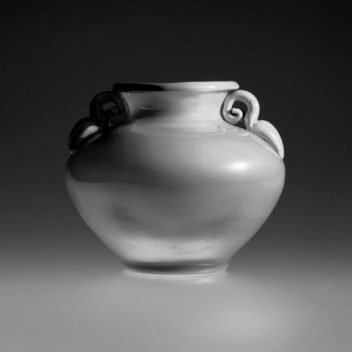
Zecchin-Martinuzzi Vetri Artistici e Mosaici 1932–1938
In 1932, the two Muranese partners of Paolo Venini—engineer Francesco Zecchin and the sculptor and designer Napoleone Martinuzzi—left the Vetri Soffiati Muranesi Venini & C. and founded their own company: Zecchin-Martinuzzi Vetri Artistici e Mosaici. Its production was directed by Martinuzzi who, inspired by the sculptural qualities of the Novecento movement, created large vessels in opaque glass, animals, and cactus in pasta vitrea and female nudes in massiccio glass. In some cases, the company also collaborated with Mario Romano and Giovanni Guerrini. Napoleone Martinuzzi left the company in 1936, and after two years Francesco Zecchin closed it for good.
Napoleone MartinuzziPasta vitrea, 1933
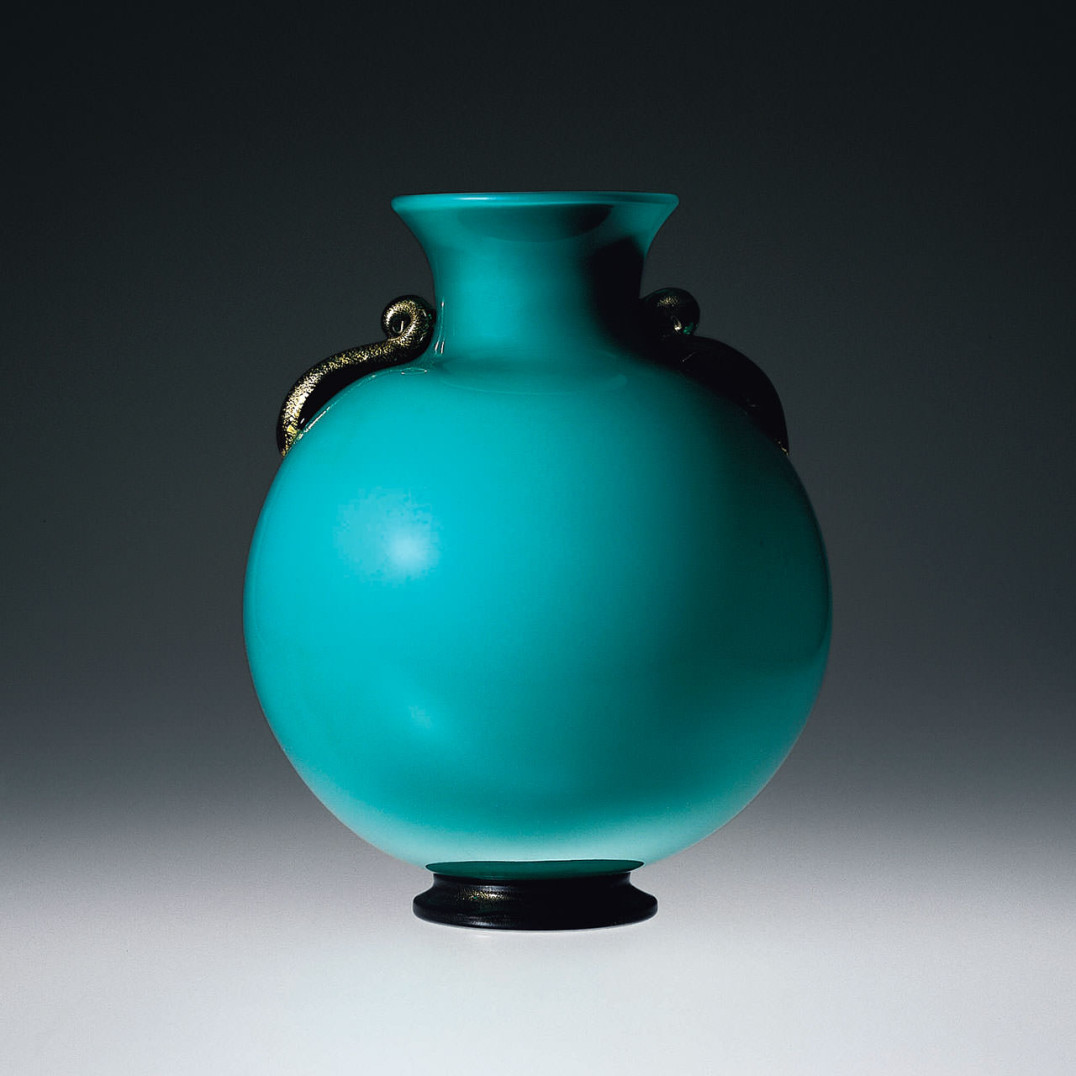
Napoleone MartinuzziIncamiciato, 1932
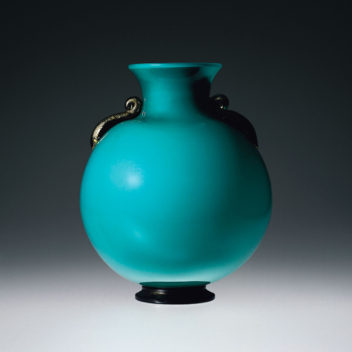
Napoleone MartinuzziIncamiciatoZecchin-Martinuzzi Vetri Artistici e Mosaici, 1932
Vase in lattimo glass cased in turquoise glass with two handles and foot decorated with applications of gold leaf.
13 1/4 in. high (33.6 cm)
Exhibitions:
2000, New York, Venetian Glass, Museum of Arts & Design;
2001, Milan, Murano: Vetri dalla Collezione Olnick Spanu, Spazio Oberdan.
Bibliography and comparative texts:
Mille anni…, 1982, n. 541;
M. Barovier, 1992, nn. 62, 63;
Olnick Spanu, 2000, n. 15;
Olnick Spanu, 2001, n. 28.

Napoleone Martinuzzi 1892–1977
The son of a glassworker from Murano, Napoleone Martinuzzi was a sculptor, designer, and businessman. He attended the Accademia di Belle Arti di Venezia, and later joined the secessionist group of Cà Pesaro, where he exhibited his sculptures in 1908. From 1917 on, he was Gabriele D'Annunzio's favorite artist and he designed a funeral monument for him, as well as sculpture and many works in glass, which may still be seen today at the Vittoriale. Between 1921 and 1931, he directed the Museo Vetrario di Murano, and in 1925 he became a partner and artistic director at the Vetri Soffiati Muranesi Venini & C. After carrying on the concepts defined by his predecessor, Vittorio Zecchin, and creating beautifully transparent blown glass pieces, he elaborated on his own distinct style, directly derived from his experience as a Novecento sculptor. In 1928, he made his first pieces in pulegoso glass, giving life to a sculptural series of vessels with impressive shapes and vivid colors, as well as an unusual collection of cacti, fruits, and animals. After leaving Venini, in 1932 he founded Zecchin-Martinuzzi Vetri Artistici e Mosaici with Francesco Zecchin, for which he designed figures of animals and cacti, opaque vessels with classical shapes, and female nudes in solid massiccio glass. He became artistic director of Alberto Seguso's Arte Vetro, where he made glass sculptures shaped while hot. Between 1953 and 1958, he designed chandeliers and glass tiles for the Vetreria Cenedese. In the '60s and '70s, he designed works produced by Alfredo Barbini for Pauly & C.

Zecchin-Martinuzzi Vetri Artistici e Mosaici 1932–1938
In 1932, the two Muranese partners of Paolo Venini—engineer Francesco Zecchin and the sculptor and designer Napoleone Martinuzzi—left the Vetri Soffiati Muranesi Venini & C. and founded their own company: Zecchin-Martinuzzi Vetri Artistici e Mosaici. Its production was directed by Martinuzzi who, inspired by the sculptural qualities of the Novecento movement, created large vessels in opaque glass, animals, and cactus in pasta vitrea and female nudes in massiccio glass. In some cases, the company also collaborated with Mario Romano and Giovanni Guerrini. Napoleone Martinuzzi left the company in 1936, and after two years Francesco Zecchin closed it for good.
Napoleone MartinuzziIncamiciato, 1932
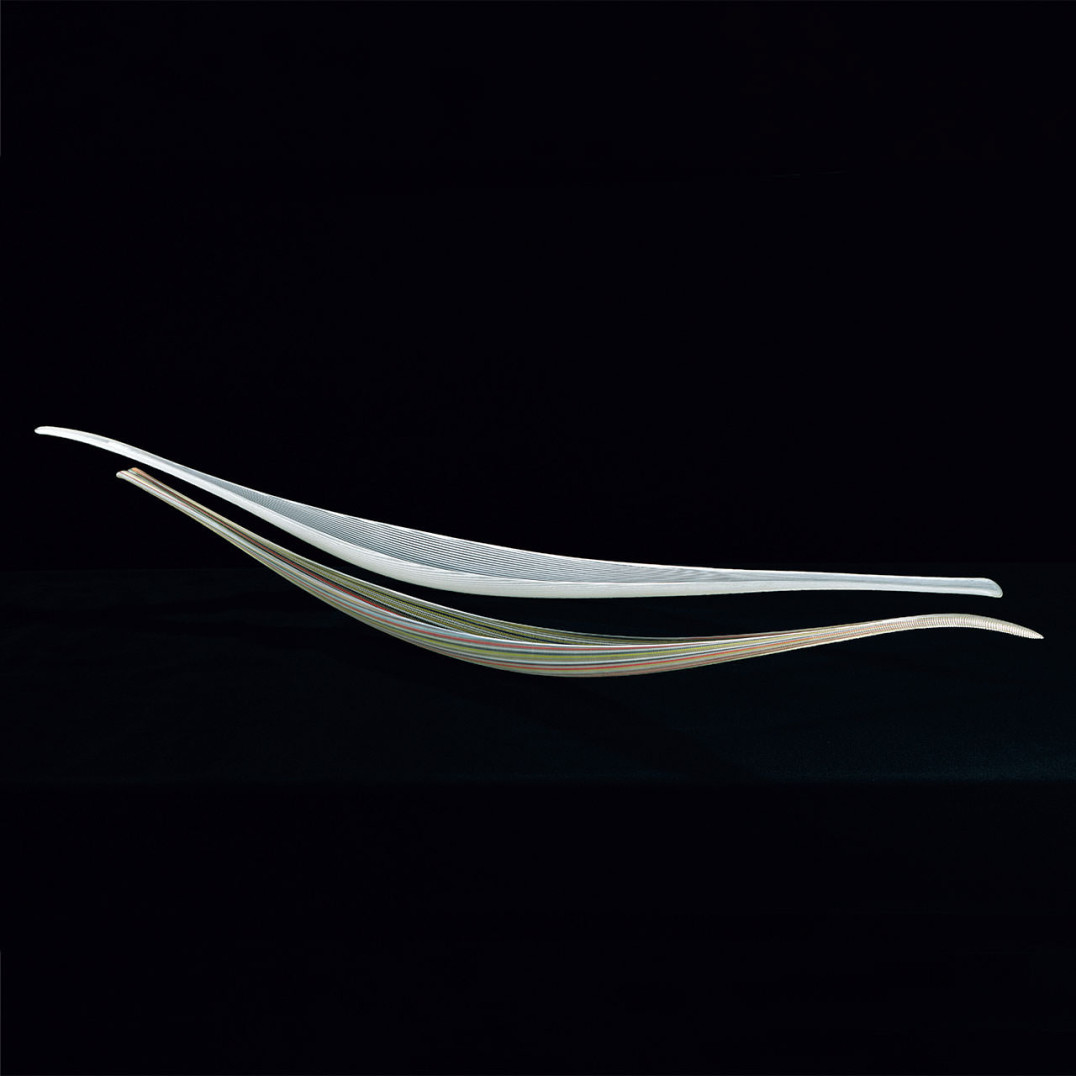
Lino TagliapietraBoats, 2000
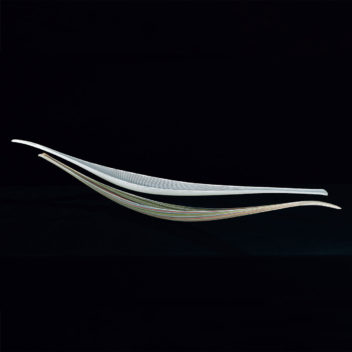
Lino TagliapietraBoats
Two boats, the one on the top composed of horizontal white glass canes, the other with multicolored canes. Both are finished with a dense and regular wheel-carved battitura.
72 1/2 in. long (184 cm)
75 1/2 in. long (192 cm)
Exhibitions:
1998, Venice, Venezia Aperto Vetro;
2000, New York, Venetian Glass, Museum of Arts & Design;
2001, Milan, Murano: Vetri dalla Collezione Olnick Spanu, Spazio Oberdan.
Bibliography and comparative texts:
International New Glass…, 1998, p. 128;
M. Barovier, 1998 (a), pp. 14, 15, 100, 101;
M. Barovier, 1999, p. 390, 391;
Olnick Spanu, 2000, n. 157;
Olnick Spanu, 2001, n. 200.

Lino Tagliapietra 1934–
Lino Tagliapietra, born on Murano, was very young when he began his apprenticeship in the furnaces. In 1956, he was maestro at the Galliano Ferro workshop and after various collaborations with Venini and La Murrina, he went to work for Effetre International as artistic director in 1976. There he was able to perfect new glass textures, which he used to make extraordinary glass pieces. Since 1979, he has taught courses in Murano glass techniques at the Pilchuck Glass School in Stanwood, Washington, and in other schools in America, France, Japan, and Australia, where he has come into contact and collaborated with other glass artists. Recognized as one of the most important interpreters of contemporary glass, he experiments with the material by using glass rods which he himself composes. He creates suggestive pieces that have the most magnificent colors and finishes and that are often textured with special grindings. In the last few years, the artist has furthered his artistic development with a series of installations where the multiplication of single elements, complete in and of themselves, creates a new expressive language. More recently, he has used glass to obtain large panels composed of thick rods, sectioned in different ways, which are laid down to form a brightly colored fabric with an effect comparable to extraordinary pictorial works. His works have achieved widespread acclaim and are part of the collections of major international museums such as the Victoria and Albert Museum in London, the Corning Museum of Glass in Corning, New York, the Musée des Arts Décoratifs in Paris, and others.
Lino TagliapietraBoats, 2000
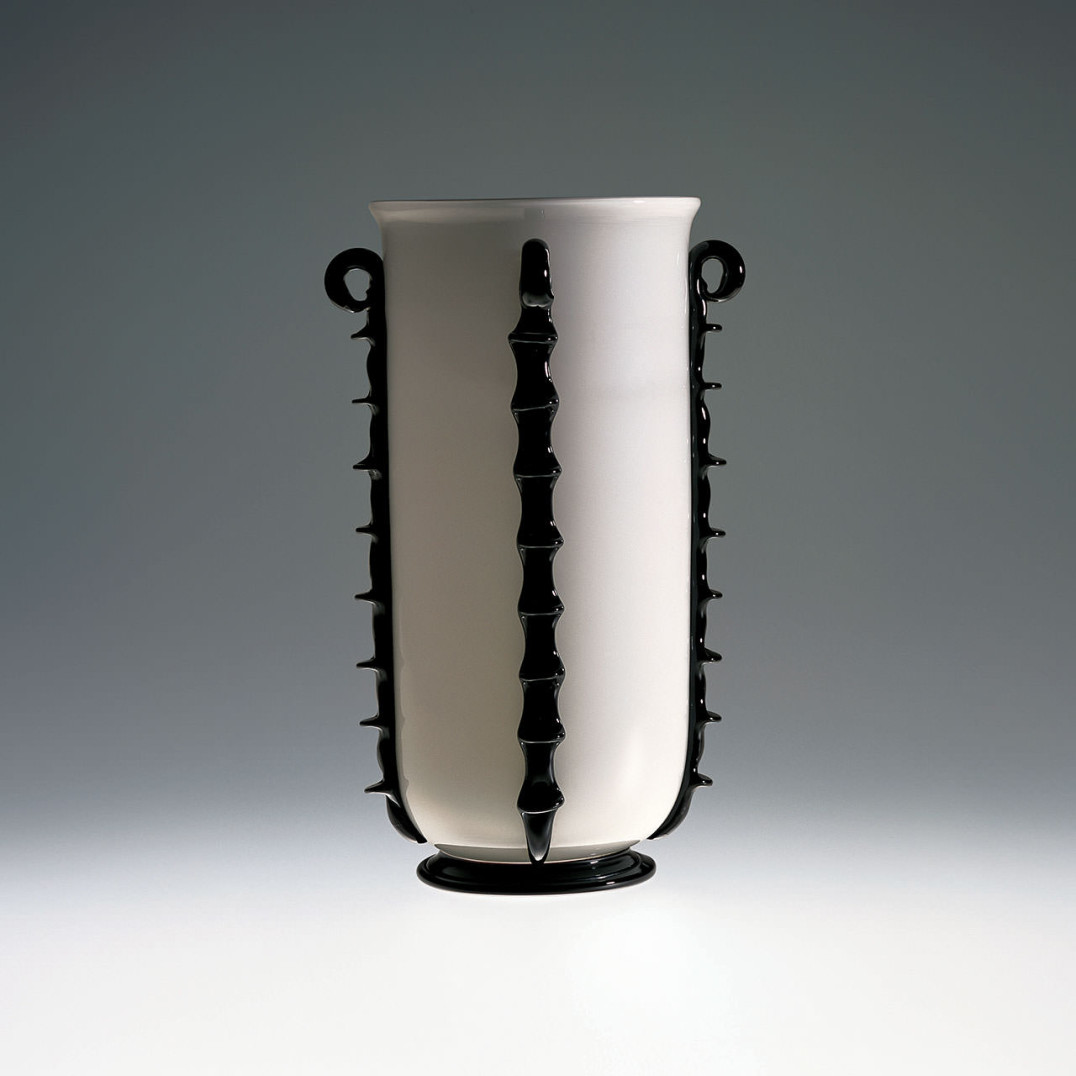
Napoleone MartinuzziIncamiciato, 1930
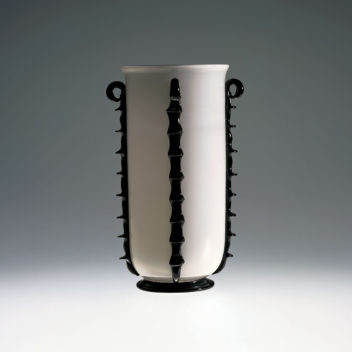
Napoleone MartinuzziIncamiciatoV.S.M. Venini & C., 1930
Vessel in lattimo glass with foot
and a morise decoration in black
pasta vitrea.
11 3/4 in. high (29.8 cm)
Ø; 7 1/4 in. (18.4 cm)
Exhibitions:
2001, Milan, Murano: Vetri dalla Collezione Olnick Spanu, Spazio Oberdan.
Bibliography and comparative texts:
Venini Catalogue, n. 3282;
Gli anni di…, 1987, n. 33;
R. Bossaglia, M. Quesada, 1988,
n. 339;
F. Deboni, 1989, n. 31;
Duplani Tucci, 1989, n. 17;
Olnick Spanu, 2001, n. 29.

Napoleone Martinuzzi 1892–1977
The son of a glassworker from Murano, Napoleone Martinuzzi was a sculptor, designer, and businessman. He attended the Accademia di Belle Arti di Venezia, and later joined the secessionist group of Cà Pesaro, where he exhibited his sculptures in 1908. From 1917 on, he was Gabriele D'Annunzio's favorite artist and he designed a funeral monument for him, as well as sculpture and many works in glass, which may still be seen today at the Vittoriale. Between 1921 and 1931, he directed the Museo Vetrario di Murano, and in 1925 he became a partner and artistic director at the Vetri Soffiati Muranesi Venini & C. After carrying on the concepts defined by his predecessor, Vittorio Zecchin, and creating beautifully transparent blown glass pieces, he elaborated on his own distinct style, directly derived from his experience as a Novecento sculptor. In 1928, he made his first pieces in pulegoso glass, giving life to a sculptural series of vessels with impressive shapes and vivid colors, as well as an unusual collection of cacti, fruits, and animals. After leaving Venini, in 1932 he founded Zecchin-Martinuzzi Vetri Artistici e Mosaici with Francesco Zecchin, for which he designed figures of animals and cacti, opaque vessels with classical shapes, and female nudes in solid massiccio glass. He became artistic director of Alberto Seguso's Arte Vetro, where he made glass sculptures shaped while hot. Between 1953 and 1958, he designed chandeliers and glass tiles for the Vetreria Cenedese. In the '60s and '70s, he designed works produced by Alfredo Barbini for Pauly & C.
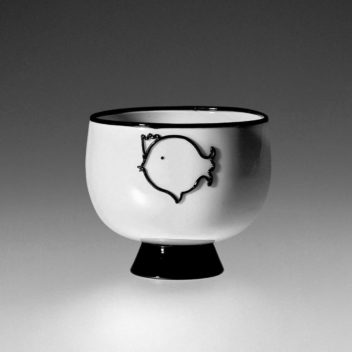
V.S.M. Venini & C. 1925–1932
In 1925, following the closing of Cappellin Venini & C., Paolo Venini founded his own glass company, which he called Vetri Soffiati Muranesi Venini & C. (V.S.M. Venini & C.). While the company, under the artistic direction of sculptor Napoleone Martinuzzi, produced collections designed by Vittorio Zecchin, it soon became known for the pulegosi, an original style created by Venini and Martinuzzi. In 1932, both Martinuzzi and Zecchin left the company. Paolo Venini changed the name of the company to Venini & C. and Milanese architect Tommaso Buzzi became the new artistic director.
Napoleone MartinuzziIncamiciato, 1930
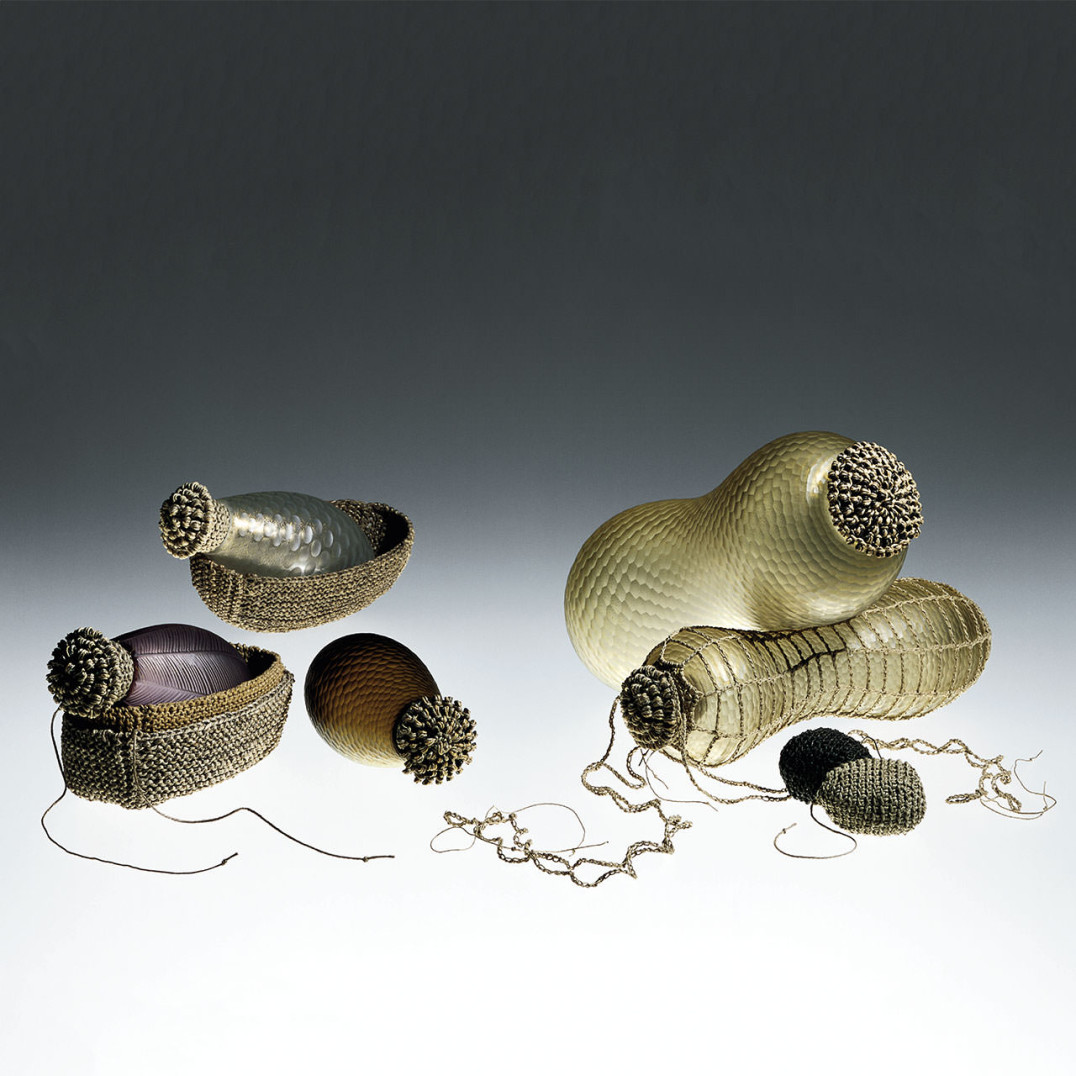
Cristiano BianchinNidi, semi e fusi, 1996

Cristiano BianchinNidi, semi e fusi
A grouping of five nidi, semi, and fusi resting in or among baskets. All glass pieces are transparent aubergine, clear, or straw colored. The surfaces are battuto with applied gold leaf throughout. The corolle, baskets, and other elements are handwoven in hemp by the artist.
8 in. long (20.3 cm)
8 in. long (20.3 cm)
8 in. long (20.3 cm)
13 in. long (33 cm)
13 in. long (33 cm)
Exhibitions:
1996, Venice, Venezia Aperto Vetro;
1998, Venice, Venezia Aperto Vetro;
2000, New York, Venetian Glass, Museum of Arts & Design;
2001, Milan, Murano: Vetri dalla Collezione Olnick Spanu, Spazio Oberdan.
Bibliography and comparative texts:
International New Glass, 1996, p. 101; International New Glass, 1998, p. 59;
New tradition…, 1998, pp. 28-33; Olnick Spanu, 2000, n. 163;
Olnick Spanu, 2001, n. 199; D. Klein, 2001, p. 31.

Cristiano Bianchin 1963–
Born in Venice, where he lives and works, Cristiano Bianchin attended the Accademia di Belle Arti di Venezia, where he studied under the direction of the renowned artist Emilio Vedova and graduated with a degree in painting in 1987. Since 1984, he has exhibited at public institutions and private galleries, and his first personal show was held at the Galleria Bevilacqua La Masa in 1987. As an emerging artist, Bianchin conceives his own artistic language as a reading of experimental poetics involving the possible exchange between the sensuality of seeing and the materials used in art. His first experiments in glass date from 1992 and have been presented in numerous collective and personal exhibitions, such as the one held in 1995 at the Museo Antonio Canova (also known as the Possagno) near Treviso. Bianchin views his work with glass as having an evolutionary continuity based on the classical validity of glassworking techniques, which he confronts with the experimentation of new sculptural forms. His Nidi date from 1996: they are works conceived as mineral architectures whose surface is textured using the refined Murano glass techniques of battitura and molatura. Between 1998 and 1999, he created his Riposapesi, in which the blown glass pieces, black or vividly colored, are synthetically austere. Bianchin was selected in 1995 and 1997 as the Italian artist at the Corning Museum of Glass in New York. He participated at Aperto Vetro, the International Exhibition of Contemporary Glass in Venice, in 1996 and 1998.